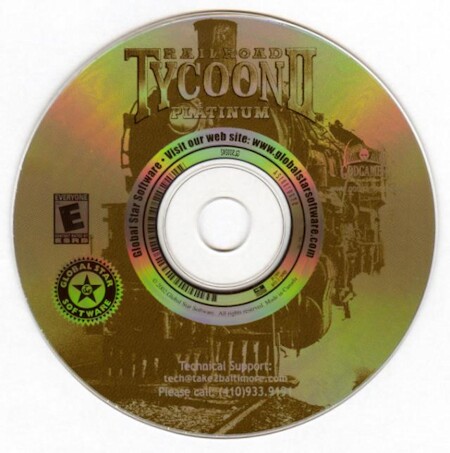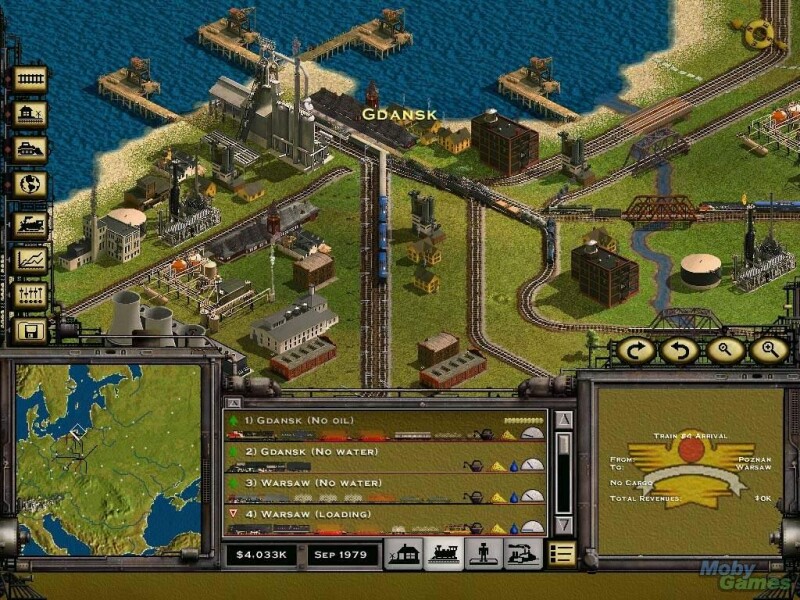
Actual Game
Railroad Tycoon II
|
The Game
Railroad Tycoon II Platinum is an ultimate edition of Railroad Tycoon II. It contains the original game, the Second Century expansion, the additional levels from the Gold edition, fifty new scenarios, an electronic copy of the official strategy guide and (most importantly) over 2 hours of new music.
Simply put, Railroad Tycoon II is an excellent sequel to an excellent game. The spirit of the first best-selling sim has been kept intact, yet so much has changed on the surface that Railroad Tycoon II has a very fresh feel to it. The most obvious change is its appearance - Railroad Tycoon II presents a nice isometric smooth view of the game map, runs at 1024x768 resolution in 16-bit color, and can be zoomed in and out or rotated to any major compass direction. With the scenario and map editor, you can create game worlds for any terrain or location you wish. The world is your locomotive oyster.
Some may expect Railroad Tycoon II to be a train set game. To some extent it is, but the focus is geared far more to the economic side of running a railroad than to the simulation of trains running. You have to manage trains, routes and cargos, but the detail of the running of the trains is abstracted somewhat, and to win at the hardest difficulty settings you have to fully grasp the ins and outs of such things as stocks, dividends, prices, selling short and buying on margin. This economic bent is no doubt a result of Steinmeyer's lengthy experience gained working in the financial sector, but those who have nightmares over the thought of balancing books in the face of stiff AI competition can turn to the relative safety of the sandbox mode where that competition is non-existent and resources are infinite.
Railroad Tycoon II is in reality a business simulation, and the business is hauling goods over railways. The first concept to grasp is that you play as a railroad baron with your own personal fortune, and you can start railroad companies, become their chairman and manage their separate accounts. If you want to start up two companies, you can. If you want to run a company into the ground and bale out (as, for example, a defensive tactic to a takeover), you can. Depending on the scenario goal, different tactics will come into play. The distinction between personal wealth and company wealth is certainly important though. When starting your first company you will need outside investment - take a large external investment and you have more money to play with, but less share of that company, and thus less profit to gain from rises in its share value. One of the keys to personal success is having your company stock split; for that you need profit, and that takes investment. Balancing profit and investment is the key to success in Railroad Tycoon II. A mind-twisting Catch-22, and one that makes the game so challenging.
On the railroad side of things you can lay track, build bridges, build stations, add improvements to stations, buy trains, set routes and specify what cargos are run from where to where. Cargos are run by a train and consist along a set route - you can pick up or "sell" at any station. As time progresses industries come and go and cities expand, depending on the rail activity around them. The skill comes in assessing where profitable routes lie, and where they will lie in the future, and deploying stations, track and trains to exploit them. However, if you play on the more advanced industry rules, supply and demand have an effect - stations will only pay for goods they demand, and if they're over-supplied the price is likely to fall, and industries will only produce if supplied. The industry rules also determine whether you can buy specific industries themselves - by doing so you can get a nice little earner from the industry, so long as it's busy, whether by your activities or that of rival companies.
The ability to set the level of complexity for the industrial and financial models is welcome. For beginners, the "sandbox" mode is ideal, as it allows you to see how industries interact without any financial pressure. Each of the industrial and financial models can be set to one of three levels of "realism". On the financial side, this determines whether you can buy stock in other companies, sell short or buy on margin, or initiate takeovers. These are natural difficulty modifiers, and you can also tweak the revenue modifiers for human and computer companies to allow further handicapping.
There are two ways to play Railroad Tycoon II. You can load any of the game maps and play an open game. There's no random map generator but the resources on the maps are randomized with each game. The maps included cover several views of the US, South America, Europe, the Far East, China and Africa. India is an absentee. The maps are detailed, accurate, and also fully tweakable in the game editor if there's any particular things you want to change.
The other way to play the game is via a (non-linked) campaign of 18 scenarios, mostly taken from notorious feats in railroading history. Scenarios have goals to be achieved (e.g. linking two cities and running so many loads between them) and have three levels of success - gold, silver or bronze - depending on whether you meet the subgoals too. Each scenario has you pick one of three "benefits" to use in that scenario, a measure for some extra replay value no doubt. The campaign is structured as a sort of tutorial in that the best ways to win the scenarios teach you new tricks. That's not to say they're puzzle oriented, or that there's only ever one way to win - far from it - but you learn the ropes through experience. The biggest money-spinner is passenger and mail, so you invariably start off with a few "people runs". If that pays off, diversify into runs which take raw materials, supply factories and then run those manufactured goods to cities. Trouble is, while you're doing that you have to watch what financial plays the AI opponents are up to.
The most impressive part of Railroad Tycoon II is the amount of features and options built into it. The 100-page manual does a very good job of explaining all those features, and is written in an engaging and light style. It lists all the options, and has appendices which detail all the railroad chairmen, managers, locomotives and industries in the game. What the manual lacks is any real guide on how to succeed at the game - some designer notes and hints would have been very welcome.
A big run in Railroad Tycoon II could be a train running non-stop over half the game map, in the early game this will probably be a passenger/mail train, where easier money is to be had. In game terms the train may take a year to do the run, so obviously the actual running of trains is abstracted, and is representative of the average running of a service. That said, with huge incomes coming in when a long haul service arrives (assuming it didn't get robbed) the timing of arrivals can be critical, and some key financial plays can be made based on this. Likewise, track can be laid instantly, and while the cost is based on length and terrain, this is another abstraction (though since the first train will move slowly over the track in game time, you could imagine the track being laid slower and it not affecting the gameplay per se). For those lamenting the lack of tunnels and points, there is some gameplay bonus. Hills force high track gradients, so you need to use "gruntier" locos for such sections. Points are absent, but you can set train priorities (express, normal, slow) - if trains meet on the same lane of single or double track one will "grey out" until the other passes. Another abstraction. Again, focus is on finance, not point-switching.
As time drifts by, new industries and locomotives show up. You may be offered an exclusive deal on a new locomotive for a fee, thus gaining the jump on the opposition. Adapting to changes in industrial demands is always important, more so when completely new industries appear on the map. By looking at the game editor you can see how the mechanics of this work - regions can be set up in which various industries have set chances of appearing, and triggers can be set up that when activated cause events, of which there are dozens of types. The game features around 60 locomotives, from slow gradient-busters to modern very high speed trains. There's some 36 industries, each of which takes some form of goods and delivers something from it, and there's a similar number of cargo wagon types, plus the caboose (which deters robberies) and dining car (which increases passenger revenues, at the cost of more weight, which slows the train down, reducing passenger revenues, decisions, decisions).
Another character feature is the presence of managers. These are the heroes of the railroad, and your company can have one manager on its books at any time. Each manager has different bonuses/penalties, and each their price. Some might help cut down on robberies, others improve safety. More useful benefits include faster trains and lower track-laying costs. Each game year two new managers offer themselves to you, and getting a good manager is worthwhile, but not critical to success. Which one is best depends on the scenario or situation you're in at the time - there's no real killer manager.
The ambiance of the game is enhanced by some superb blues music - there's about 15 tracks and they cycle through during the game. General sound effects are good, but the background music is certainly something players might turn up rather than turn off. It's arguably the best background music in any PC strategy game I've played. Windowed video-clip footage of trains, construction workers and the like add a pleasant dose of period atmosphere, as do the newspaper reports that pop up. The latter often include clues as to such things as imminent turns in the economy. The spoken mission instructions in the campaign game are also quite witty and appropriate - it's worth staying idle at the selection screen to get an ear-bashing from the old timer who chats to you there, and to hear what he has to say about the designer in the credits section.
The editor is superb, with two main elements, a map editor and a scenario editor. Terrain is painted on via airgun brushes. Hills and valleys are created by mouse dragging and placing towns and industries is simple. Rivers are a special case - water terrain can't be bridged, but rivers can be. If you're patient then you could create some pretty realistic world maps - map creation is a game in itself, and Railroad Tycoon II's editor allows you to make very pretty, as well as functional, maps.
Once the map is designed or selected, you can set up all the scenario conditions and properties - which trains are used, which managers, which player options are turned on, etc. If you want to bar players from starting up multiple companies you can, for example. You can program triggers that generate events, such as a boom in passenger traffic. The trigger conditionals can get complex, and a separate file exists on the CD for those who want to delve deeply into it. The potential is there for some very cunning scripting.
Railroad Tycoon II is an engrossing game. It's strength lies in its portrayal of a cutthroat business environment, while blending in an equally engrossing railroad creation element. The AI robber barons are very adept at pulling every trick the game rules allow, and if you try to compete at the hardest settings you'll repeatedly get a bloodied nose until you begin picking up the tricks of the trade. The campaign offers progressively more difficult scenarios, in which you have to slowly adapt and learn, and these are very enjoyable.
There isn't really a game that comes close to Railroad Tycoon II for offering the chance to hack and slash opponents to pieces over stocks, shares and slick trading. The financial plays available within the game are varied and numerous, and thinking of new tricks and devious ploys is always fun. Railroad Tycoon II is in short, a great game. It combines an intense business sim with shirtsleeves railroad design. You too could be the next Cornelius Vanderbilt.




